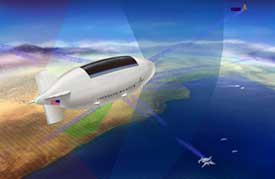2006 05 16
From DARPA | defenseindustrydaily.com

Lockheed HAA Concept |
DARPA's ISIS program is developing a stratospheric airship with sensor antennas that will include a radar nearly as large as the airship. This would create a battlefield surveillance platform with extreme endurance, and equally extreme resolution for its air and battlefield scans via radar and other carried sensors. This project is associated with Lockheed's High Altitude Airship program, which is intended to soar at over 65,000 feet for over a month at a time, and could also play a significant role in ballistic missile and cruise missile defense.
Like all DARPA projects, ISIS is pushing the limits of technology. Critical technology areas requiring further development include low aerial-density advanced airship hull material, extremely low-power transmit-receive modules for the radars, and novel power systems for long-endurance stratospheric airship operation.
Recent contracts illustrate some of those efforts:
ISIS Contracts
Unless otherwise specified, all contracts are issued by The Air Force Research Laboratory in Rome, NY.
May 12/06: Raytheon Systems Co. in El Segundo, CA received an $8 million indefinite delivery/indefinite quantity contract to develop Lightweight, Low-Power Density Active Electronically Scanned Array (AESA) technology for the DARPA ISIS program. The AESA to be developed is dual band (UHF and X-Band) and bonded to the flexible hull material of the airship. The AESA radar to be developed is to be dual band (UHF and X-Band) and bonded to the flexible hull material of the airship. If it's possible, this could allow the radar's 'aperture' to be almost as large as the blimp itself, providing incredible resolution!
The Air Force can issue delivery orders totaling up to this maximum amount. Negotiations were complete April 2006, and work will be complete April 2008 (FA8750-06-C-0048).
April 28/06: Lockheed Martin Corp. in Littleton, CO received an $8.8 million cost-plus fixed-fee contract associated with the Integrated Sensor IS Structure (ISIS) critical technology development program. The goal is to perform preliminary design/analysis, development and validation testing of a direct current efficient transceiver to minimize the prime power requirement of large aperture phased array platform.
Prototype testing will occur during the course of this effort, and monthly status and final technical reports will be delivered. Lockheed will also be cooperating with other contractors in the ISIS programand sharing information. Work will be complete by April 2008 (FA8750-06-C-0046).
April 21/06: Northrop Grumman Corp. Electronic Sensors and System Section in Linthicum Heights, MD received an $8.7 million cost-plus fixed-fee contract to develop a lightweight, low-power density Active Electronically Scanned Array (AESA) radar technology for the DARPA Integrated Sensor is Structure (ISIS) program. The AESA radar to be developed is to be dual band (UHF and X-Band) and bonded to the flexible hull material of the airship.
The final deliverable is to Feasibility of Flexible Scanned Array. Solicitations began in March 2006, negotiations were complete in April 2006, and work will be complete by April 2008. The Air Force Research Laboratory in Rome, NY issued the contract (FA8750-06-C-0049).
Article from: http://www.defenseindustrydaily.com/2006/05/darpas-isis-
project-seeks-slow-soaring-surveillance-superiority-updated/index.php
Related: Pentagon Prepares To Build $130bn Robot Army
US robot builds copies of itself
Pentagon plans cyber-insect army
Warbots to Replace Human Soldiers?
Beam weapons almost ready for battle
Robot Demonstrates Self Awareness
Honeywell Begins Flight Tests Of New 13-Inch UAV
Predator UAV 'Battle Lab' Just North of Las Vegas
Vehicle-Mounted Active Denial System (V-MADS)
